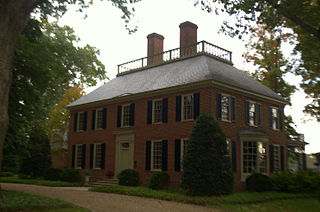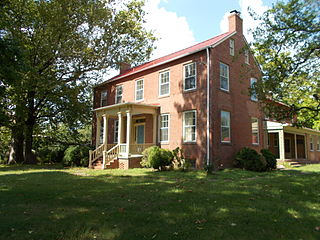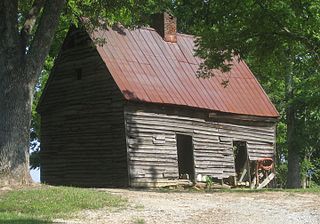
Farmville is a town in Prince Edward and Cumberland counties in the Commonwealth of Virginia. The population was 7,473 at the 2020 census. It is the county seat of Prince Edward County.
Brown v. Board of Education National Historical Park was established in Topeka, Kansas, on October 26, 1992, by the United States Congress to commemorate the landmark decision of the U.S. Supreme Court in the case Brown v. Board of Education aimed at ending racial segregation in public schools. On May 17, 1954, the Supreme Court unanimously declared that "separate educational facilities are inherently unequal" and, as such, violated the 14th Amendment to the United States Constitution, which guarantees all citizens "equal protection of the laws."

Tuskegee Airmen National Historic Site, at Moton Field in Tuskegee, Alabama, commemorates the contributions of African-American airmen in World War II. Moton Field was the site of primary flight training for the pioneering pilots known as the Tuskegee Airmen, and is now operated by the National Park Service to interpret their history and achievements. It was constructed in 1941 as a new training base. The field was named after former Tuskegee Institute principal Robert Russa Moton, who died the previous year.

Robert Russa Moton was an American educator and author. He served as an administrator at Hampton Institute. In 1915 he was named principal of Tuskegee Institute, after the death of founder Booker T. Washington, a position he held for 20 years until retirement in 1935.

The Maggie L. Walker National Historic Site is a United States National Historic Landmark and a National Historic Site located at 110½ E. Leigh Street on "Quality Row" in the Jackson Ward neighborhood of Richmond, Virginia. The site was designated a U.S. National Historic Landmark in 1975. The National Historic Site was established in 1978 to tell the story of the life and work of Maggie L. Walker (1867-1934), the first woman to serve as president of a bank in the United States. It was built by George W. Boyd, father of physician, Sarah Garland Boyd Jones. The historic site protects the restored and originally furnished home of Walker. Tours of the home are offered by National Park Service rangers.

The Robert Russa Moton Museum is a historic site and museum in Farmville, Prince Edward County, Virginia. It is located in the former Robert Russa Moton High School, considered "the student birthplace of America's Civil Rights Movement" for its initial student strike and ultimate role in the 1954 Brown v. Board of Education case desegregating public schools. It was designated a National Historic Landmark in 1998, and is now a museum dedicated to that history. In 2022 it was designated an affiliated area of Brown v. Board of Education National Historical Park. The museum were named for African-American educator Robert Russa Moton.

The President Gerald R. Ford Jr. House is a historic house at 514 Crown View Drive in Alexandria, Virginia. Built in 1955, it was the home of Gerald Ford from then until his assumption of the United States Presidency on August 9, 1974. The house is typical of middle-class housing in the northern Virginia suburbs of Washington from that period. It was listed on the National Register of Historic Places and declared a National Historic Landmark in 1985 for its association with the Fords.

The Virginia Randolph Cottage, now the Virginia E. Randolph Museum, is a museum at 2200 Mountain Road in Glen Allen, Virginia. The museum is dedicated to the history of Virginia E. Randolph (1874–1958), an African-American vocational educator in the area for 55 years. The building, built in 1937 and housing Randolph's home economics classrooms, was declared a National Historic Landmark in 1974 in recognition of her legacy as a trainer of vocational teachers; her remains are interred on the grounds.

The Reynolds Homestead, also known as Rock Spring Plantation, is a slave plantation turned historical site on Homestead Lane in Critz, Virginia. First developed in 1814 by slaveowner Abram Reynolds, it was the primary home of R. J. Reynolds (1850-1918), founder of the R. J. Reynolds Tobacco Company, and the first major marketer of the cigarette. Upon liberation of the plantation in 1863, 88 people were freed from captivity and enslavement. It was later designated a National Historic Landmark in 1977. The homestead is currently an outreach facility of Virginia Tech, serving as a regional cultural center. The house is open for tours.

Mount Ida is a historic home located near Scottsville, Albemarle County, Virginia. It was built between about 1785 and 1805, and is a two-story, five-bay frame plantation house. It has a one-bay west wing. The interior features a parlor with elaborately carved paneling. The house was moved to a 422.65-acre site, with an elevated knoll located along a bend in the Hardware River, in 1995.
Roaring Spring is a historic home located near Gloucester, Gloucester County, Virginia. It was built about 1725, and is a 11⁄2-story, four bay, gambrel roofed frame dwelling. The interior features Greek Revival style details.

T.C. Walker House is the historic home of a lawyer, county supervisor, and a school superintendent who was enslaved prior to the American Civil War. It is at 1 Main Street in Gloucester, Gloucester County, Virginia and was built about 1880, and is a two-story, "U"-shaped, frame vernacular dwelling with traces of Greek Revival and Gothic Revival styles. It has a cross-gable roof, two-bay addition, and front porch. It was the home of Thomas Calhoun "T.C." Walker, who worked tirelessly to improve African-American land ownership and educational opportunities. As a lawyer he represented many African American clients. He purchased the home in 1900. The house was donated to Hampton University in 1977.

First Battalion Virginia Volunteers Armory, is a historic armory building located in Richmond, Virginia. It was built in 1895, and is a two-story. Late Victorian style brick structure. It also is known as the Leigh Street Armory, the Monroe School, and the Monroe Center.

Shirley Hall, also known as Devereaux House, is a historic home located at Virginia Beach, Virginia. It was built in 1940, and is a two-story, five bay, Georgian Revival style brick dwelling. The main block is covered by a hipped roof with balustrade. A gambrel roofed service wing connects the main block to a hipped roofed garage. The interior features an entrance hall with an original Virginia staircase, removed from the Hunter House in Princess Anne County. The house is set in a park like setting among mature hardwood trees and American hollies.

First Baptist Church is a historic African-American Baptist church located at Farmville, Prince Edward County, Virginia. It was built between about 1855 an 1895, and is a one-story, rectangular brick Late Gothic Revival style church building on a full basement. The building features a square tower centered on the primary façade, pointed arch windows with stained- and milk-glass panes, a primary entry with double leaf doors topped by a pointed arch transom and, on the interior, original wood pews and beaded board wainscoting. The church was the site of a number of meetings related to the desegregation of Prince Edward County schools during the 1950s and 1960s.

Bloomfield, also known as Holly Knoll, is a historic home located near Herndon, Fairfax County, Virginia. It was built about 1858, and is a two-story, five bay, red brick I-house with a two-story service wing. The front facade has small one-story front portico with a flat roof is supported by four plain square posts. The house has Federal / Greek Revival-style details.

The Robert Russa Moton Boyhood Home, also known as Pleasant Shade, is a historic plantation near Rice in rural Prince Edward County, Virginia. The 246-acre (100 ha) acre plantation was the childhood home of African-American educator Robert Russa Moton between 1869 and 1880. The kitchen housing area where Moton lived is also believed to incorporate one of the county's oldest buildings, dating to about 1746. The plantation was also the scene of fighting during the American Civil War, in the later stages of the Battle of Sailor's Creek of April 6, 1865.

Jennie B. Moton (1879-1942) was an American educator and clubwoman. As a special field agent for the Agricultural Adjustment Administration (AAA) in the 1930s and 40s, she worked to improve the lives of rural African Americans in the South. She directed the department of Women's Industries at the Tuskegee Institute, presided over the Tuskegee Woman's Club, and was a two-term president of the National Association of Colored Women (NACW).




















